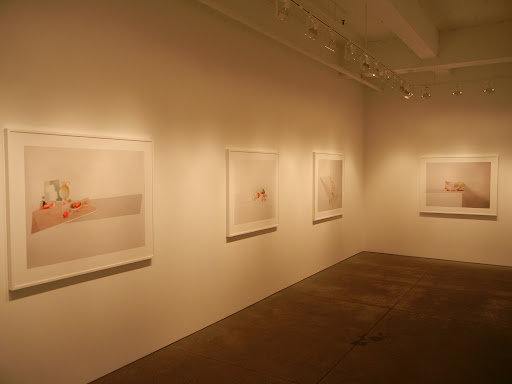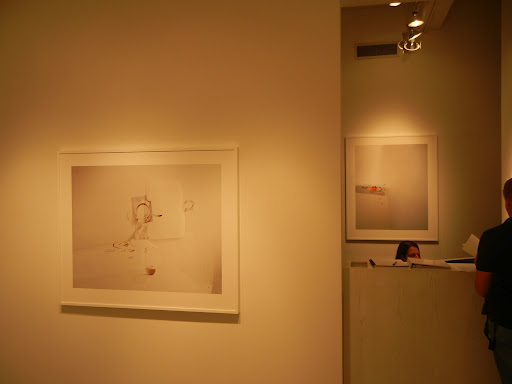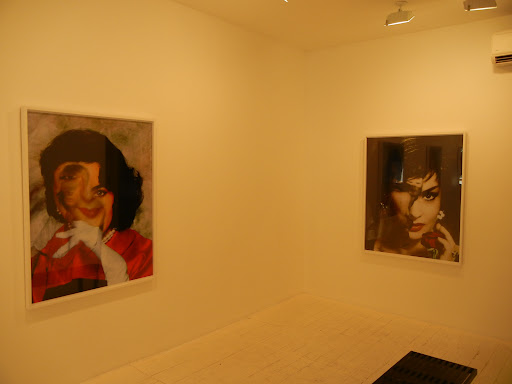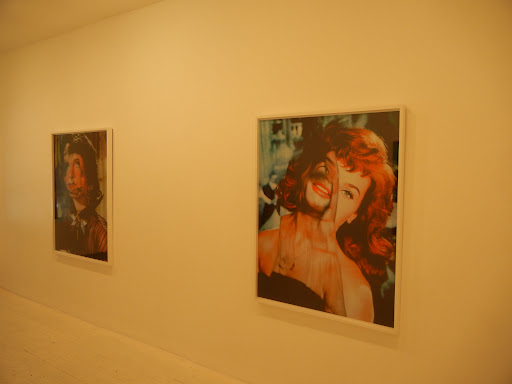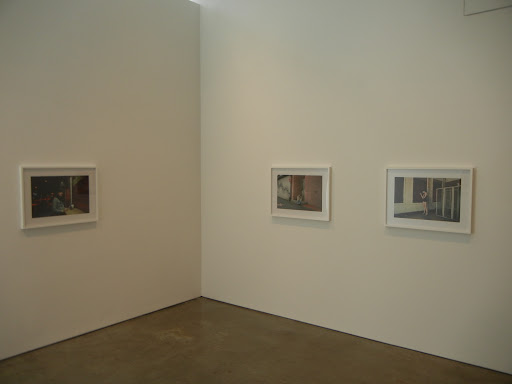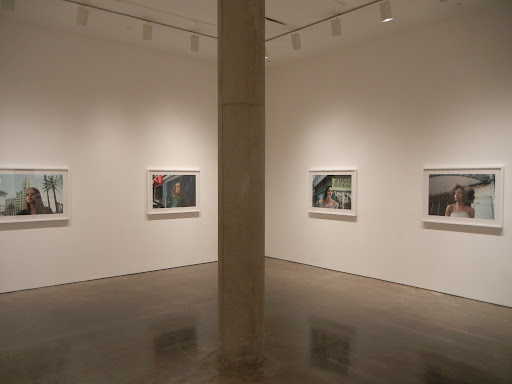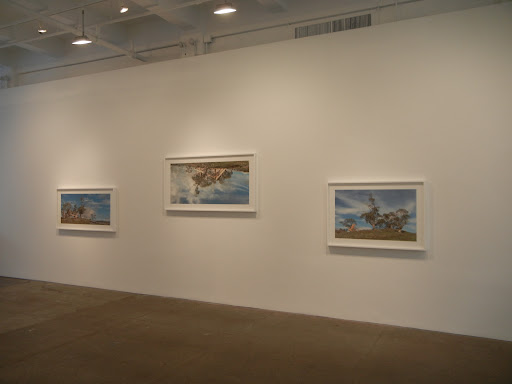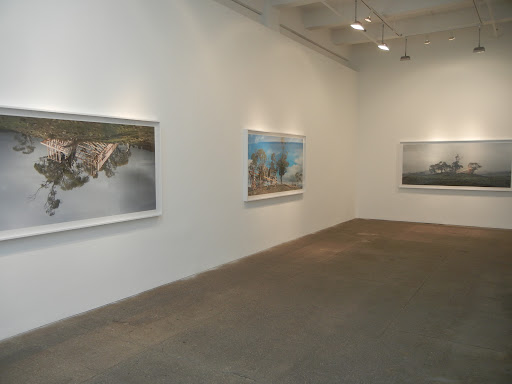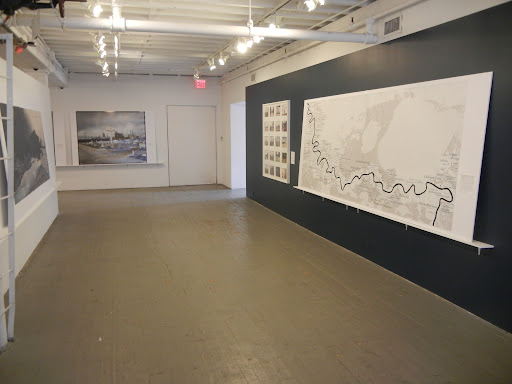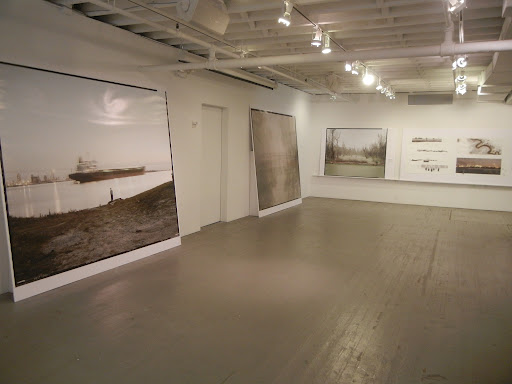 JTF (just the facts): A total of 256 black and white photographs, framed in white and matted, and hung against grey (light, medium, and dark) and green walls in a series of interconnected spaces on the first and fourth floors of the museum (a handful of works are also on view in the lobby). All of the works are gelatin silver prints made between 1965 and 2009. No dimension or edition information was available on the wall labels. Glass cases in the various exhibit rooms contain a total of 67 photobooks, and a small number of sculptures and other ephemera are also distributed throughout the show. A catalog of the the exhibition, entitled The Place We Live, A Retrospective Selection of Photographs, 1964-2009 was recently published Yale University Press (here). The exhibit was curated by Joshua Chuang and Jock Reynolds. The exhibition has already made stops in Vancouver, Denver, and Los Angeles, and has four more European venues scheduled through the summer of 2014. (Installation shots at right.)
JTF (just the facts): A total of 256 black and white photographs, framed in white and matted, and hung against grey (light, medium, and dark) and green walls in a series of interconnected spaces on the first and fourth floors of the museum (a handful of works are also on view in the lobby). All of the works are gelatin silver prints made between 1965 and 2009. No dimension or edition information was available on the wall labels. Glass cases in the various exhibit rooms contain a total of 67 photobooks, and a small number of sculptures and other ephemera are also distributed throughout the show. A catalog of the the exhibition, entitled The Place We Live, A Retrospective Selection of Photographs, 1964-2009 was recently published Yale University Press (here). The exhibit was curated by Joshua Chuang and Jock Reynolds. The exhibition has already made stops in Vancouver, Denver, and Los Angeles, and has four more European venues scheduled through the summer of 2014. (Installation shots at right.)
The show is divided into titled sections, each accompanied by wall text drawn from one of the artist’s books. For each section or case, I have detailed the number of prints/books on view and their dates:
Lobby gallery
- 6 gelatin silver prints, 1999
 First Floor galleries
First Floor galleries
- The Plains: 8 gelatin silver prints, 1965-1973
- Eden: 8 gelatin silver prints, 1968
- The New West: 22 gelatin silver prints, 1968-1971
- Case: White Churches of the Plains (1), The Architecture and Art of Early Hispanic Colorado (1), Prairie (2), 2 gelatin silver prints, 1968, 1974
- Summer Nights: 13 gelatin silver prints, 1976-1982
- Ludlow: 5 gelatin silver prints, 1978
- Case: Eden (2), The New West (3), Commercial Residential (2), Summer Nights (2), Summer Nights: Walking (2)
- Book display: 3 volumes, The Place We Live, 1 gelatin silver print, 1978
- What We Bought: 31 gelatin silver prints, 1973-1974
- Cottonwoods: 11 gelatin silver prints, 1973-1995, 1 cottonwood bark fragment, 1982
- The Pawnee National Grassland: 6 gelatin silver prints, 1984
- The Missouri West: 10 gelatin silver prints: 1975-1983
- Our Parents, Our Children: 15 gelatin silver prints, 1981
- Case: Our Lives and Our Children (1), No Small Journeys (2), From The Missouri West (2), Beauty In Photography (3)
- Screenprint: Beautiful Small Town Names
 Fourth Floor galleries
Fourth Floor galleries
- Los Angeles Spring: 21 gelatin silver prints, 1978-1983
- Case: Los Angeles Spring (2), Listening To The River (2), California (2), Gone? (2), Notes From Friends (1), Why People Photograph (1)
- Along Some Rivers: 28 gelatin silver prints, 1984-1987
- The Pacific: 17 gelatin silver prints, 1991, 2003, 1 wooden sculpture
- Turning Back: 22 gelatin silver prints, 1976, 1999, 2003
- Case: To Make It Home (1), West From The Columbia (2), Time Passes (1), Turning Back (2), Tree Line (2)
- Small reading room: 4 prints paired with poems by A.R. Aamons, Emily Dickinson, William Blake, and Zbigniew Herbert
- Case: Pine Valley (2), A Portrait In Landscapes (2), Still Lies The Manzanita (2), I Hear The Leaves And Love The Light (2), Along Some Rivers (2), 2 eroded rocks
- Pine Valley: 6 gelatin silver prints, 2001-2003
- Bodhisattva: 5 gelatin silver prints, 1999
- Alder Leaves: 5 gelatin silver prints, 2004
- The War In Iraq: 6 gelatin silver prints: 2004-2007
- Sea Stories, This Day: 8 gelatin silver prints, 1999-2009, 1 carved sculpture, 2001, 1 notebook
- Case: Alders (2), Questions For An Overcast Day (2), Bodhisattva (2), Sea Stories (1), This Day (2), Close At Hand (2), Skogen (2), What Can We Believe (1), 1 wood sculpture
 Comments/Context: A year or two ago, I wrote a review of a Paul Graham show where I argued that Graham was an insider’s photographer, an artist who was well known and highly esteemed inside the photographic community but largely unknown outside it. I was immediately shouted down by the masses of the converted, who were all too happy to point out my daft ignorance. Today, I am going to make a similar assertion about Robert Adams, and I assume that my inbox will fill once again with a flood of vehement protestations.
Comments/Context: A year or two ago, I wrote a review of a Paul Graham show where I argued that Graham was an insider’s photographer, an artist who was well known and highly esteemed inside the photographic community but largely unknown outside it. I was immediately shouted down by the masses of the converted, who were all too happy to point out my daft ignorance. Today, I am going to make a similar assertion about Robert Adams, and I assume that my inbox will fill once again with a flood of vehement protestations.
On one hand, I think a very compelling case can be made that Adams is a truly radical innovator who has fundamentally and permanently redefined the nature (no pun intended) of American landscape photography. Adams’ long term influence is undeniable: I have met plenty of photographers who count him as one of their photographic heroes, and his books, writings, and teachings continue to have countless ardent, cult-like followers. On the other hand, I think there is a largely silent body of viewers who react to Adams’ work with much less enthusiasm, finding it often ugly, underwhelming, and a bit boring. Its dissimilarity to what they have come to expect from the landscape genre (the dramatic grandeur of Ansel Adams) makes some of the work very hard to connect to; it doesn’t reveal itself so quickly or boldly. In our first years of collecting, I will admit to having been in this second camp; I found his images to be like parsnips or kale – things I was supposed to like, that were obviously good for me, but which in all honesty, I found somewhat less than entirely tasty. Over the years, and with a growing shelf full of Adams’ eloquent books in our library, I have gradually moved closer to the supporters point of view, slowly being won over by the consistent craftsmanship, elegance, thoughtfulness, and quiet beauty in even the most distressing and damaged of his photographs. So it was with some excitement that I traveled to Yale to see this grand, traveling retrospective, in the hopes of clarifying and deepening my understanding of his work once and for all. I’m afraid my findings are likely to offend both sides, as ample evidence of both the truly great and the truly forgettable is on view.
Covering roughly 45 years of time, the exhibition is gathered into thematic groups (both large and small), roughly mirroring bodies of work as they were originally presented in book form. In many ways, this helps to recreate some of the intimate sequencing and storytelling that is the hallmark of Adams’ books, but strictly speaking, this retrospective is not rigidly chronological, as some subjects span decades and others overlap or jump around in time. To help clarify the overall “which came first” ordering (at least in my own mind), I have taken the dates of the images on view (by grouping) and laid them out on the timeline below:

Adams’ early square format pictures from the late 1960s feel rooted in vernacular American modernism and a reverence for traditional American landscape photography. They echo the spare purity of a Paul Strand or a Walker Evans: an angular white church, the towering form of white grain elevator, broad grassland views with massive 19th century clouds. But his Eden pictures which follow signal the beginning of a new approach: this Eden isn’t the leafy garden of snakes and apple trees we all know, it’s a dusty flat expanse of interstate highway and dry desert, decorated with truck stops and gas stations. Seeing these pictures is like watching a light go on – it suddenly becomes obvious that there is another way to see the geography of the land, that the word landscape can be applied not only to classically beautiful mountains and rivers, but to the evidence of the human relationship to the natural world. There is a sense of discovery here, a philosophical opening of a door.

In the first half of the 1970s, Adams took these initial insights and expanded them, making some of the most unflinchingly critical photographs that had ever been made of the American West. With a deep respect for the unspoiled land and a frustrated eye for the environmental destruction puzzlingly taking place out in the open, Adams documented the boom town expansion of various Colorado towns (particularly Denver and its suburbs) and watched with ironic candor as whole cities were raised out of the water-less dust. His now-iconic book
The New West chronicled the inhumanity of these newly built environments: subdivisons were laid out, messy construction ensued, and the result was an endless sea of flat one story houses, clustered trailers and arrow straight roads. Adams’ pictures are an inversion – they’re not a rah-rah celebration of our ingenuity, our hard work or our can-do spirit; instead, they show us our own self-inflicted, unvarnished stupidity and our stunning disrespect for the grandeur of the land and sky.
What I find fascinating about these pictures is that they were actually surprisingly well aligned with earlier American landscape photographs that openly celebrated the majesty of the land. But instead of searching out the most beautiful vistas to make his point (like his predecessors), Adams made his argument for the critical importance of the land by capturing our destruction of it. In New Topographics-speak, we were now in the realm of the “man-altered” landscape, and Adams’ view of these modifications was alternately acerbic, distrustful, grief stricken, and downright angry. Other pictures from this same time (the What We Bought series) dive deeper into the grim lives of the inhabitants and their drab offices, liquor stores, fast food joints, and dreary strip mall convenience stores. There is a sense of being both offended and deeply saddened by the tradeoffs we have made in our development of the West, a pervasive pessimism to be found in the imperfections of these communities. These pictures present a depressing reality, but I think Adams’ lasting contribution to photography is to be found in these early 1970s images and their precise examination of our separation from and disregard for the bounty of nature.

The second half of the decade found Adams channeling these core conceptual ideas in several different but adjacent directions. He followed the Missouri River out to the western edge of the nation, taking long elevated views of tire tracked prairies, rocky mesas near nuclear weapons test grounds, and smoggy mountains. He walked the lyrical nighttime streets of suburban neighborhoods, finding both shadowy menace and silent warm nostalgia: weedy sidewalks, bright carnival rides, empty chairs sitting under a porch light. And he explored the scrublands of sprawling Los Angeles, with its aging eucalyptus windbreaks, its dry washes filled with garbage, its defoliated development roads, and its ever encroaching highways. Environmental damage (and the related emotional distress) was never far from view, but hope began to creep in now and again as a balance against the constant urgent critique.
His projects in the early 1980s continued this pattern of gradual softening, as if Adams himself was becoming worn down and was in need of a few moments of optimism. Against the backdrop of soul draining suburban parking lots, he found multi-generational caring as expressed in embraces, carried babies, and hand held children. In the Pawnee National Grassland, he enjoyed huge, tumbling skies, vast open grass, and unspoiled sunflowers against a barbed wire fence. And along unnamed rivers, he exchanged an airplane for a hawk, reveled in the whiteness of fresh snow cover, and examined the delicate textures of dirt roads. Adams seemed to be saying that there was indeed beauty to be found in these landscapes if we were patient enough to look for it.
.

Given the timeline above and the span of photographic projects that Adams has generated since 1985, I think it is fair to say that his work has slipped a bit in recent years. The one exception to this is the sheer horror of the clearcut hillsides of
Turning Back. The delimbing machines, the enduring stumps, the violence and devastation of the whole process, the photographs have all the fury and tragedy of Adams’ earlier work. His question (found on a wall text and in the book) about who brings a child to see the wastelands of these close cropped hills is particularly poignant and troubling I think, and the sense of futility and failure in the pictures is heavy. And while I have a soft spot for the sublime cracked silhouettes of the alder leaves, I can’t really hold these up as new or groundbreaking; they’re just quietly meditative and beautiful. Beyond these two projects, very little will be durable I fear. Nearly all of Adams’ images of the sea lack the emotional punch of his landscapes, even when they incorporate piles of flotsam and dirty sand. And his still lifes and Iraq war boots miss the mark entirely in my view. Perhaps there is some inverse relationship between the power of his images and the power of his words, as his recent books have been full of engaging, eloquent, and memorable ideas.
Retrospectives are designed to help us trace connection points and the evolution of artistic ideas, and I think this exhibition is highly successful in showing the gestation of Adams’ original conceptual view point, its development and expansion over time, and its ultimate waning and subtle transformation. I think it cements Adams’ rightful place in the pantheon of American landscape photographers, and highlights his consistently genuine and thoughtful concern for the way we have treated the land. That his flashes of brilliance have become less frequent since the 1970s hardly matters; his imprint on our ability to see the impact of our environmental choices is permanent. If there is one recurring visual motif in Adams’ work, it is the open empty dirt road, cutting across the vastness of the landscape, vanishing into the horizon; there are likely a dozen of these pictures scattered throughout the show. At first, the road is discouraging in its slash across the unspoiled natural world. Later, it is perhaps assimilated and accommodated, shaded by an overhanging cottonwood tree, becoming part of the landscape itself, telling us something of our history. And going forward, it points the way to the future. What Robert Adams brought to landscape photography was an alternately caustic and graceful eye for these changes, an ability to show us what we didn’t want to acknowledge or had somehow overlooked, with the hope that it would knock some sense into us, so that our journey down that long road would be smarter and more aware.
 Collector’s POV: This is a museum show, so there are of course no posted prices. Adams’ photographs have become increasingly available in the secondary markets in the past decade, with prices ranging between $5000 and $87000. Adams is represented in New York by Matthew Marks Gallery (here) and in San Francisco by Fraenkel Gallery (here).
Collector’s POV: This is a museum show, so there are of course no posted prices. Adams’ photographs have become increasingly available in the secondary markets in the past decade, with prices ranging between $5000 and $87000. Adams is represented in New York by Matthew Marks Gallery (here) and in San Francisco by Fraenkel Gallery (here).
Rating: *** (three stars) EXCELLENT (rating system described here)
Transit Hub:
- Review: Hartford Courant (here)
Robert Adams, The Place We Live
Through October 28th
Yale University Art Gallery
1111 Chapel Street
New Haven, CT 06510
 JTF (just the facts): A total of 24 black and white photographs, framed in black and matted, and hung in the main gallery space and the smaller back room. All of the works are gelatin silver prints, taken in 1973 and printed recently. The images come from two series (The Suicidist and The Murdered Brother), each of which is made up of a total of 17 images (not all are on display in this show). Each print is sized 14×22, and comes in an edition of 1+1AP. (Installation shots at right.)
JTF (just the facts): A total of 24 black and white photographs, framed in black and matted, and hung in the main gallery space and the smaller back room. All of the works are gelatin silver prints, taken in 1973 and printed recently. The images come from two series (The Suicidist and The Murdered Brother), each of which is made up of a total of 17 images (not all are on display in this show). Each print is sized 14×22, and comes in an edition of 1+1AP. (Installation shots at right.)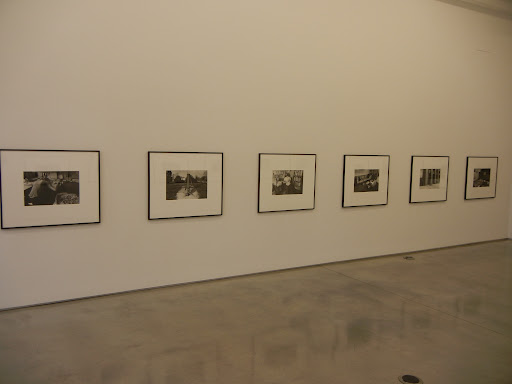 The Murdered Brother riffs on many of the same themes, albeit in a more abstracted and indirect way. The dead body in these images has been replaced by a curious white rubber glove, partially inflated and poking out from any number of puzzling and inopportune locations. It’s stuck in the oven door, creeping out of the dryer pipe, wedged under the toilet seat, trapped in the piano, stuffed in a boot, and trying to escape from the vacuum. The stories in this series are much more obtuse and unknowable, more open for interpretation, but still playfully melodramatic and inventive.
The Murdered Brother riffs on many of the same themes, albeit in a more abstracted and indirect way. The dead body in these images has been replaced by a curious white rubber glove, partially inflated and poking out from any number of puzzling and inopportune locations. It’s stuck in the oven door, creeping out of the dryer pipe, wedged under the toilet seat, trapped in the piano, stuffed in a boot, and trying to escape from the vacuum. The stories in this series are much more obtuse and unknowable, more open for interpretation, but still playfully melodramatic and inventive.